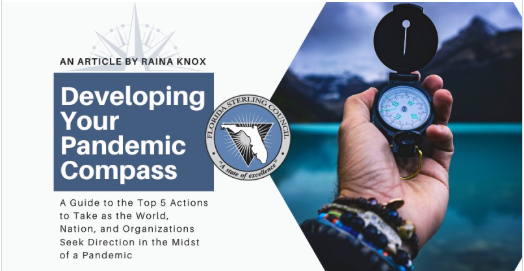What if our “new normal” is just normal now?
How many times in the last four months have these thoughts crossed your mind?
- We will work remotely until things return to normal.
- We will spend more time at home nesting with the family until things return to normal.
- We will implement temporary measures to protect our employees from this virus and to keep the company running until things return to normal.
- We must return to some sort of normal. We must find a way to re-open and stay open.
- What will our new normal look like next month or six months from now?
We are in the midst of a storm seeking a compass. Occasionally the storm clears, we see the light and we think a clearing is ahead, but it isn’t. We watch the dashboards daily to identify the trends for positive tests, hospitalizations, and deaths. We struggle to make plans for ensuring the sustainability of our organizations without precedence and predictable data to guide projections and critical decisions.
In the absence of organizational normalcy, we need an approach to assess the organizational situation, identify priorities, allocate resources, and adjust direction as new data is available.
Here are the top five things to establish your organization’s pandemic compass:
1. Assess and Strengthen the Organizational Foundation.
Conduct an assessment of the environment surrounding your organization. Identify the changes impacting your organization’s ability to create, manufacture, sell, and support product and service delivery. The natural inclination is to think environmental changes are negative, but through proactivity and thoughtful management, we can transform change.
The ability to effectively process change is to first identify the impact. A simple tool to use is a SWOT (Strengths, Weaknesses, Opportunities, and Threats) analysis focusing specifically on the environment as it is presenting and as it could evolve using best- and worst-case scenarios. Identifying organizational strengths provides the opportunity to identify new shifts in organizational direction. Weaknesses should be prioritized, and the most impactful weaknesses should be resolved or mitigated. The feasibility of opportunities may be dramatically different in the pandemic environment. Consider how organizational strengths can facilitate the most positive outcome to potential opportunities. Threats should be assessed as to likelihood of occurrence and degree of impact. The completion of a SWOT analysis combined with a detailed action plan with ownership identified provides an action-oriented path forward.
2. Ensure a Safe Environment for Employees.
The ability to deliver organizational products and services is dependent upon employees impacted by the pandemic in all aspects of their lives. A 360 degree review of the work environment and processes is a starting place for the identification of changes needed to ensure a safe environment for employees. In addition, employee engagement can be impacted by personal and family health and safety concerns. Consider the formation of a cross functional team focused on evaluation of the evolving work environment and dedication to ongoing adjustments to support employee health and safety. Communicate the organization’s pandemic response plan frequently and clearly to facilitate understanding of the organization’s priorities and plans for what may be a rapidly changing environment.
3. Check in with Customers, Stakeholders, Partners and Vendors.
Quickly contact customers to determine changes in needs and anticipated purchases. Communicate the measures in place to ensure ability to support customers and potential opportunities to adjust products and services based on customer needs. Communicate Pandemic response plans and adjustment in processes. Proactive collaboration with stakeholders, partners and vendors can support efficiency in product and service delivery and provide early identification of potential interruptions to supply chains.
4. Align Organizational Design to Ensure Plan Execution.
The development of action plans and alternative ways of delivering organizational products and services may require changes to organizational design or a need to establish temporary work teams to compensate for reduced capacity or alternative work schedules and locations. Proactive identification of the resources required to successfully implement changes and actions plans will be an important step in the development of implementation plans. Agility, innovation and a commitment to considering new approaches may be differentiating factors to navigation of an unprecedented environment.
5. Establish a Leadership Review Process.
The development of an organizational pandemic compass should be supported by the ability to adjust direction, evaluate alternatives, remove barriers, and deploy resources. Leadership oversight and frequent situational review can ensure the organization sustains the direction needed to navigate the changing environment. Frequent communication to employees, customers, stakeholders, and vendors will support alignment with the organizational direction.
What now?
We are living in unprecedented times requiring strong focus, proactive analysis, execution of action plans and continuous evaluation of organizational results. Developing your organization’s pandemic compass may be what successfully weathers your organizational sustainability through the storm – so put it in your pocket, and let it help guide your way.
